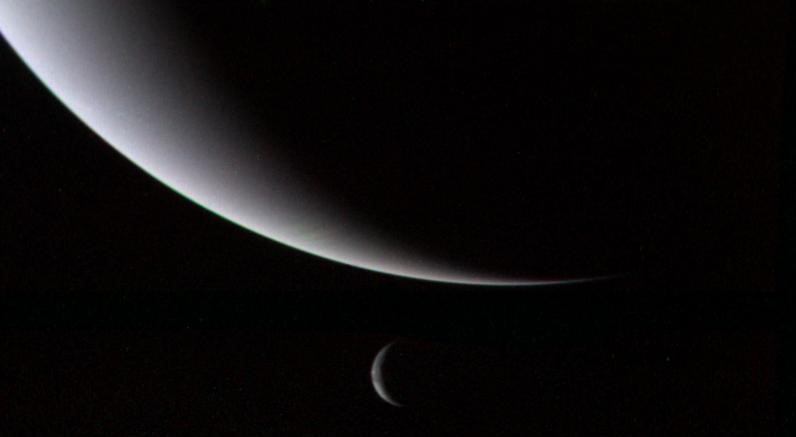Neptune's Moons
Neptune has at least 14 moons known to orbit it. Its largest moon is Triton which was discovered in 1846 by the English beer brewer and astronomer William Lassell. It was discovered only 17 days after Neptune itself was first observed. Triton is the only major moon of a planet to orbit in the opposite direction of the planet's rotation. This retrograde orbit suggests that Triton might not have originally formed around Neptune as most large moons do, but was captured by it instead.

Voyager 2 is a spacecraft that visited Neptune in 1989. Prior to its arrival, the only moon other than Triton to be discovered in orbit of Neptune was Nereid by the Dutch astronomer Gerard Kuiper in 1949. Voyager 2 would find most of Neptune's known inner moons. Astronomers have since discovered a handful of other moons orbiting Neptune. These are mostly outer moons orbiting at great distances away from Neptune. Its most distant moon is Neso which is over 48 million kilometres (30 million miles) away from Neptune itself, making it the most distant moon of any planet in the solar system.
Neptune's moons can be split into four distinct groups as listed below. Following that is a list of the moons themselves.
Groups of Neptune's Moons
List of Neptune's Moons
| Name of Moon | Diameter | Orbital Distance | Length of Orbit | Discovered | Discoverer | Group |
|---|---|---|---|---|---|---|
| Naiad | 60 km
(96 x 60 x 52 km) 38 miles |
48,277 km 29,998 miles |
7 hours | 1989 | Voyager Imaging Team | Inner |
| Thalassa | 81 km
(108 x 100 x 52 km) 51 miles |
50,075 km 31,115 miles |
7.5 hours | 1989 | Voyager Imaging Team | Inner |
| Despina | 156 km
(180 x 148 x 128 km) 97 miles |
52,526 km 32,638 miles |
8 hours | 1989 | Voyager Imaging Team | Inner |
| Galatea | 175 km
(204 x 184 x 144 km) 109 miles |
61,653 km 38,309 miles |
10 hours | 1989 | Voyager Imaging Team | Inner |
| Larissa | 194 km
(216 x 204 x 168 km) 121 miles |
73,548 km 45,701 miles |
13 hours | 1981 | Harold J. Reitsema, William B. Hubbard, Larry A. Lebofsky, David J. Tholen | Inner |
| Hippocamp | 34 km
21 miles |
105,300 km 65,430 miles |
23 hours | 2013 | Mark Robert Showalter and team | Inner |
| Proteus | 420 km
(436 x 416 x 402 km) 261 miles |
117,647 km 73,102 miles |
27 hours | 1989 | Voyager Imaging Team | Inner |
| Triton | 2,707 km
1,682 miles |
354,760 km 220,437 miles |
141 hours | 1846 | William Lassell | Major |
| Nereid | 340 km
211 miles |
5,513,400 km 3,425,861 miles |
360 days | 1949 | Gerard Kuiper | Prograde |
| Halimede | 62 km
39 miles |
15,730,000 km 9,774,150 miles |
1880 days | 2002 | Matthew J. Holman, J. J. Kavelaars, Tommy Grav, Wesley C. Fraser, Dan Milisavljevic | Retrograde |
| Sao | 44 km
27 miles |
22,420,000 km 13,931,115 miles |
2914 days | 2002 | Matthew J. Holman, J. J. Kavelaars, Tommy Grav, Wesley C. Fraser, Dan Milisavljevic | Prograde |
| Laomedeia | 42 km
26 miles |
23,570,000 km 14,645,691 miles |
3168 days | 2002 | Matthew J. Holman, J. J. Kavelaars, Tommy Grav, Wesley C. Fraser, Dan Milisavljevic | Prograde |
| Psamathe | 38 km
24 miles |
46,700,000 km 29,017,979 miles |
9117 days | 2003 | Scott S. Sheppard, David C. Jewitt, Jan Kleyna | Retrograde |
| Neso | 60 km
37 miles |
48,390,000 km 30,068,094 miles |
9374 days | 2002 | Matthew J. Holman, Brett J. Gladman and teams | Retrograde |





